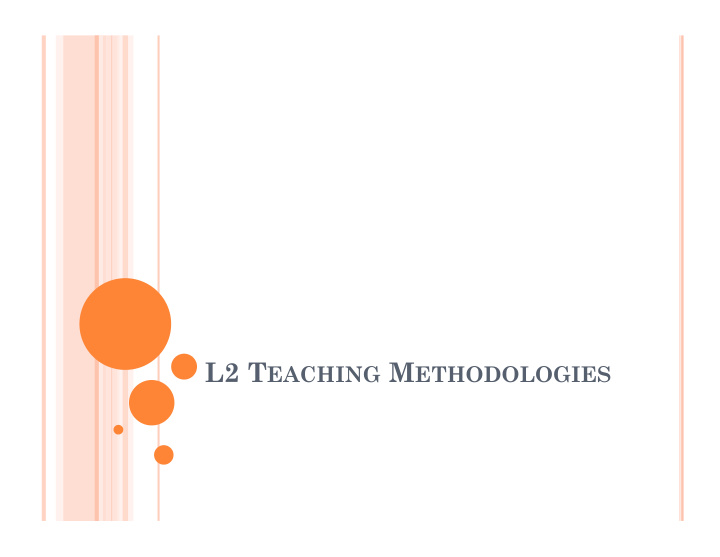



L2 T EACHING M ETHODOLOGIES
A PPLIED L INGUISTICS The application of certain material to a practical use Second language acquisition (SLA) Language planning Artificial intelligence Translation
T HE PLAN L2 Teaching Methodology Characteristics Examples A closer look: Two approaches to grammar instruction Evaluating L2 Writing
S OME L2 T EACHING M ETHODOLOGIES Language-centered Methods Grammar Translation Audiolingual Method Learning-centered Methods Direct Method Natural Approach Learner-centered Methods Communicative Method
G RAMMAR T RANSLATION Focus on rules and translation Based on the teaching methodology of ancient Latin and Greek Ignores How most people learn elements of language How native speakers actually use elements of language Reading and translating ✓ Speaking ✗
D IRECT M ETHOD Learn the L2 like the L1 Teach only in the Target Language Mime, visuals Teach only vocabulary and phrases used in colloquial speech Small, intensive classes focus on oral skills (easy to hard, based on interaction between student and teacher) Inductive grammar instruction (though feedback and examples) Emphasis on correct pronunciation and grammar
D IRECT M ETHOD Do you think adults learn their L2 the same way that they learn their L1? In what contexts would this method of teaching be more appropriate?
A UDIOLINGUAL M ETHOD
A UDIOLINGUAL M ETHOD Influenced by Behaviorism Tabula rasa Learning though stimulus Describe recurring themes to make generalizations Focus on phonology and morphology
N ATURAL A PPROACH Based on the Monitor Model: Distinction between learning (conscious) and acquisition (subconscious) There is a natural order to L2 acquisition Input must be meaningful and understandable (but at one level higher than the learner) Lower the affective filter
C OMMUNICATIVE M ETHOD
C OMMUNICATIVE M ETHOD Objectives: Include all components of communicative competence Grammatical, sociolinguistic, discursive, strategic Function, rather than form, is not a priority Success is measured by the interlocutor’s comprehension and not on “correctness” Goal of production and comprehension of the L2 in spontaneous contexts
THE RELEVANCE OF GRAMMAR INSTRUCTION Grammar for grammar’s sake Teach regular –ed form with its two pronunciation variants Teach doubling rule for verbs that end in d (for example, wed wedded ) Hand out a list of irregular verbs that students must memorize Do pattern drills for –ed Do substitution drills for irregular verbs
THE RELEVANCE OF GRAMMAR INSTRUCTION Grammar for communication’s sake Distribute two narratives, each one to half of the class Teach the regular –ed form, using verbs that occur in the texts as examples Teach doubling and pronunciation rules if those form occur in the texts Teach irregular verbs that occur in the texts Students read the narratives, ask questions for comprehension Students work in pairs to interview each other in order to recount orally or written the story they have not read
T HINGS TO CONSIDER There is no one right method Different learning styles Different personalities Different goals for learning the L2 Combining methodologies is a good idea
E VALUATING L2 W RITING Correct form Coding for self-correction Circle errors for self-correction Content only Content + form What are some advantages and disadvantages of the above evaluation strategies?
Q UESTIONS / CONCERNS / THOUGHTS ?
Recommend
More recommend